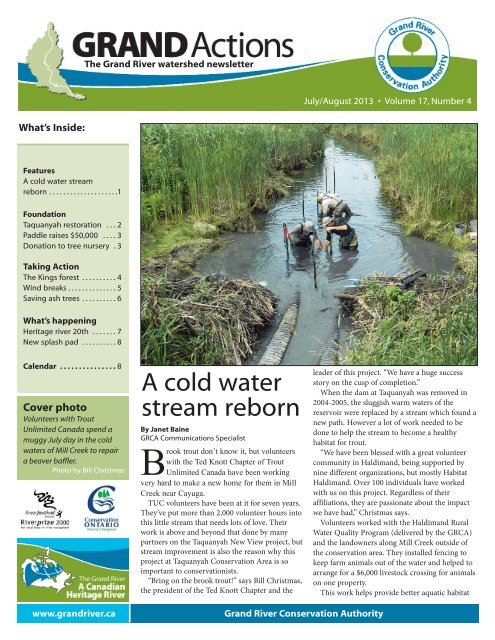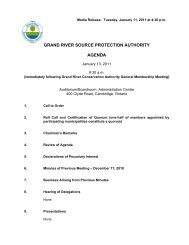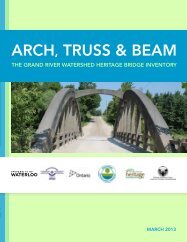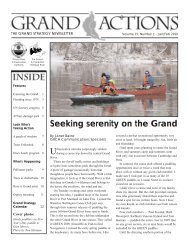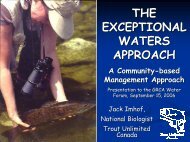July/Aug. - Grand River Conservation Authority
July/Aug. - Grand River Conservation Authority
July/Aug. - Grand River Conservation Authority
Create successful ePaper yourself
Turn your PDF publications into a flip-book with our unique Google optimized e-Paper software.
The <strong>Grand</strong> <strong>River</strong> watershed newsletter<br />
<strong>July</strong>/<strong>Aug</strong>ust 2013 • Volume 17, Number 4<br />
What’s Inside:<br />
Features<br />
A cold water stream<br />
reborn . . . . . . . . . . . . . . . . . . . .1<br />
Foundation<br />
Taquanyah restoration . . . 2<br />
Paddle raises $50,000 . . . . 3<br />
Donation to tree nursery . 3<br />
Taking Action<br />
The Kings forest . . . . . . . . . . 4<br />
Wind breaks . . . . . . . . . . . . . . 5<br />
Saving ash trees . . . . . . . . . . 6<br />
What’s happening<br />
Heritage river 20th . . . . . . . 7<br />
New splash pad . . . . . . . . . . 8<br />
Calendar . . . . . . . . . . . . . . . 8<br />
Cover photo<br />
Volunteers with Trout<br />
Unlimited Canada spend a<br />
muggy <strong>July</strong> day in the cold<br />
waters of Mill Creek to repair<br />
a beaver baffler.<br />
Photo by Bill Christmas<br />
A cold water<br />
stream reborn<br />
By Janet Baine<br />
GRCA Communications Specialist<br />
Brook trout don’t know it, but volunteers<br />
with the Ted Knott Chapter of Trout<br />
Unlimited Canada have been working<br />
very hard to make a new home for them in Mill<br />
Creek near Cayuga.<br />
TUC volunteers have been at it for seven years.<br />
They’ve put more than 2,000 volunteer hours into<br />
this little stream that needs lots of love. Their<br />
work is above and beyond that done by many<br />
partners on the Taquanyah New View project, but<br />
stream improvement is also the reason why this<br />
project at Taquanyah <strong>Conservation</strong> Area is so<br />
important to conservationists.<br />
“Bring on the brook trout!” says Bill Christmas,<br />
the president of the Ted Knott Chapter and the<br />
leader of this project. “We have a huge success<br />
story on the cusp of completion.”<br />
When the dam at Taquanyah was removed in<br />
2004-2005, the sluggish warm waters of the<br />
reservoir were replaced by a stream which found a<br />
new path. However a lot of work needed to be<br />
done to help the stream to become a healthy<br />
habitat for trout.<br />
“We have been blessed with a great volunteer<br />
community in Haldimand, being supported by<br />
nine different organizations, but mostly Habitat<br />
Haldimand. Over 100 individuals have worked<br />
with us on this project. Regardless of their<br />
affiliations, they are passionate about the impact<br />
we have had,” Christmas says.<br />
Volunteers worked with the Haldimand Rural<br />
Water Quality Program (delivered by the GRCA)<br />
and the landowners along Mill Creek outside of<br />
the conservation area. They installed fencing to<br />
keep farm animals out of the water and helped to<br />
arrange for a $6,000 livestock crossing for animals<br />
on one property.<br />
This work helps provide better aquatic habitat<br />
www.grandriver.ca<br />
<strong>Grand</strong> <strong>River</strong> <strong>Conservation</strong> <strong>Authority</strong>
etween Taquanyah and Lake Erie, which is<br />
a goal for both the GRCA and the Ministry<br />
of Natural Resources.<br />
Beavers drowned 12 hectares (30 acres) of<br />
hardwood forest near the creek and also<br />
braided the lower stream into five flows, says<br />
Christmas. That’s when volunteers installed<br />
beaver bafflers —devices that confused the<br />
beavers so their dams don’t work properly<br />
and they give up and move elsewhere.<br />
This TUC Chapter was formed eight years<br />
ago by Christmas to cover Halton, Hamilton<br />
and Haldimand. It has about 80 chapter<br />
members, with 10 from the southern <strong>Grand</strong>.<br />
TUC has worked with 16 groups on this<br />
project and enlisted help from a 4H club and<br />
their parents, stewardship rangers, the<br />
Woodlot Owners Association and others.<br />
Many volunteers are required on work days<br />
to get in the creek to move rocks and trees,<br />
and install and maintain the beaver bafflers.<br />
“The support given by the community has<br />
been exceptional. It bodes well for the future,<br />
with so many young people becoming active<br />
and dedicated. They now own this stream for<br />
the rest of their lives,” Christmas wrote in a<br />
recent article.<br />
Funders for this work include the<br />
Haldimand Rural Water Quality Program,<br />
Izaak Walton Fly Fishing Club, TD Friends<br />
of the Environment Fund, Trillium Fund,<br />
Haldimand Stewardship Foundation and<br />
Union Gas Centennial Fund.<br />
Photo by Bill Christmas<br />
By Janet Baine<br />
GRCA Communications Specialist<br />
It took a decade and a lot of work, but<br />
Mill Creek near Cayuga has finally been<br />
restored to a coldwater stream<br />
surrounded by a landscape of ponds,<br />
wetlands and Carolinian woodlands.<br />
Perseverance has paid off for the<br />
organizations that have worked together to<br />
restore the former site of the Taquanyah<br />
Reservoir. It is one of the few coldwater<br />
streams in the Southern <strong>Grand</strong> <strong>River</strong><br />
watershed.<br />
The <strong>Grand</strong> <strong>River</strong> <strong>Conservation</strong><br />
Foundation helped to bring together the<br />
partners and the $250,000 needed for the<br />
project on the GRCA property, which is also<br />
home to the Taquanyah Nature Centre.<br />
The project also brought together the<br />
GRCF and the Six Nations of the <strong>Grand</strong><br />
<strong>River</strong> who were key participants. Six<br />
Nations, through their Eco-Centre, received<br />
a $125,000 Ontario Trillium Foundation<br />
grant to cover part of the costs and also<br />
helped develop the plans to ensure their<br />
needs were met.<br />
Mill Creek is just a few kilometres long,<br />
but it is at the heart of the Taquanyah<br />
project.<br />
The <strong>Grand</strong> <strong>River</strong> Fisheries Management<br />
Plan says that removing small dams, such as<br />
Volunteers spend a Saturday in <strong>July</strong> repositioning a beaver baffler at the upstream end of<br />
Taquanyah. It had mysteriously migrated downstream through the dam because of clamps that<br />
were slipping. The volunteers devised a stronger anchoring system and re-anchored it. From left<br />
are Wade Dowling of Habitat Haldimand and Vic Cairns of TUC.<br />
New life for old dam site<br />
GRCF<br />
Taquanyah, is a good way to improve fish<br />
habitat. Dams raise water temperature,<br />
contribute to poor water quality and block<br />
fish migration.<br />
For several decades, the dam on Mill<br />
Creek created a reservoir that local people<br />
came to like. But the reservoir held warm,<br />
sluggish water that was suitable only for<br />
carp.<br />
Supported removal<br />
When local residents learned the dam was<br />
damaging aquatic life and that the problem<br />
would get worse with time, they decided to<br />
support removal of the dam. The input and<br />
passion, as epitomized by the members of<br />
Habitat Haldimand, inspired the new view of<br />
Taquanyah.<br />
Dam removal was completed in 2005,<br />
leaving an empty, moonscape terrain where<br />
the reservoir floor used to be. Once the dam<br />
was removed, the water temperature in Mill<br />
Creek dropped by about 8C.<br />
Between 2005 and 2012 the land was<br />
rehabilitated to create many different types<br />
of habitat. More than 10,000 trees and<br />
shrubs will transform parts of the property<br />
back into a Carolinian forest. Other<br />
plantings provide a buffer between the creek<br />
and the land. Volunteers with Habitat<br />
Haldimand worked extensively with<br />
landowners in the area to plant trees and<br />
shrubs along the creek on their properties.<br />
They have added fencing to keep livestock<br />
out of the water.<br />
The next step will be finding out if trout<br />
from the <strong>Grand</strong> <strong>River</strong> can be stocked in the<br />
little creek.<br />
“We couldn’t have done this without the<br />
help of the <strong>Grand</strong> <strong>River</strong> <strong>Conservation</strong><br />
Foundation,” says Warren Yerex, retired<br />
GRCA supervisor of aquatic resources.<br />
He remembers a meeting where Ron<br />
Clark, a GRCA board member from<br />
Haldimand County, said he and his wife<br />
Nancy would provide substantial funding for<br />
this project as long as matching funds were<br />
found.<br />
Many funding partners<br />
The Trillium Foundation grant helped<br />
cover the cost of four wetland features and<br />
Page 2<br />
Share the resources – Share the responsibility
earthen dykes that were designed by Ducks<br />
Unlimited Canada. A $25,000 grant also<br />
came from the Great Lakes Guardian<br />
Community Fund to complete the project in<br />
2012. Along the way, Habitat Haldimand,<br />
Shell Environmental Fund and Wetland<br />
Habitat Fund also contributed. Volunteers<br />
such as Trout Unlimited were dedicated to<br />
improvement of the area.<br />
“To me this is a great new space for people<br />
in Haldimand County,” Sara Wilbur,<br />
executive director of the <strong>Grand</strong> <strong>River</strong><br />
<strong>Conservation</strong> Foundation says. “The project<br />
took on a life of its own and there was great<br />
momentum as many partners created a<br />
unique conservation hub for the community.<br />
It is free to visit and a tremendous value for<br />
kids and families – there is nothing like it in<br />
the area.”<br />
By this fall, new interpretive signs will be<br />
added along the trails. An event to reopen<br />
Taquanyah and celebrate the 40th<br />
anniversary of the nature centre will take<br />
place this fall.<br />
About Taquanyah<br />
The Taquanyah Nature Centre was<br />
completed in the fall of 1973 and was the<br />
first interpretive nature centre that was<br />
designed by the GRCA. At the time, there<br />
were nature centres at Lake Belwood, Laurel<br />
Creek and Apps’ Mill and school board staff<br />
originated and supervised the outdoor<br />
programs at those centres. In contrast,<br />
Taquanyah was staffed by the GRCA.<br />
It meant a lot to Bruce Graham at Burford Tree<br />
Nursery to receive support for new equipment<br />
and a storage shed.<br />
Canoe Trip Raises $54,000 for GRCF<br />
Warm weather and great river flows made the second annual <strong>Grand</strong> <strong>River</strong><br />
<strong>Conservation</strong> Foundation canoe excursion from Cambridge to Paris a great<br />
success.<br />
More than 40 people gathered on Sunday May 26 to enjoy the sun, wind and each<br />
other’s company, all in support of the GRCF’s conservation projects.<br />
Guests enjoyed a mid-day riverside picnic – complete with a visit to “the old sycamore”,<br />
a familiar landmark for canoeists – along the sparkling water.<br />
Guide Garth Potruff shared background on native traditions along the river and advice<br />
on how to avoid poison ivy. The outfitter, Canoeing the <strong>Grand</strong> of Kitchener, generously<br />
supported the big flotilla of canoes.<br />
With the support of the Macquarie Group Foundation, which matched participants’<br />
donations, $54,000 was raised. This foundation is the philanthropic arm of the<br />
international company associated with Macquarie Private Wealth Inc. based in Kitchener.<br />
The GRCF extends a special thank you to Rob Caldwell of Macquarie for taking the lead<br />
in making the day such a success. Participants in the event are previous donors to the<br />
GRCF.<br />
A conservation partner at Burford nursery<br />
The heart of the GRCA’s reforestation<br />
program lies in Brant County at the<br />
Burford Tree Nursery.<br />
This is where trees and shrubs are grown<br />
for reforestation projects throughout the<br />
<strong>Grand</strong> <strong>River</strong> watershed.<br />
Roger Davis has purchased trees from<br />
Burford for years. In 2012 he visited the<br />
nursery, asked superintendent Bruce<br />
Graham to show him what was needed, then<br />
he made a significant donation. Thanks to<br />
Roger, Burford has a new storage shed and a<br />
new traveling irrigation sprinkler system to<br />
keep young trees healthy during dry<br />
weather.<br />
“It means a lot to me to get this support,”<br />
says Graham. “It helps the nursery, which is<br />
important to the authority’s tree planting<br />
program. Roger said he really feels that he<br />
has helped us out. He will see the new<br />
building go up and the travelling sprinkler is<br />
a big help to this place.”<br />
Foundation Annual Report<br />
Roger Davis is one of the many generous<br />
donors profiled in the 2012 GRCF Annual<br />
Report. The report is in the final stage of<br />
production and will soon be available on<br />
www.grcf.ca.<br />
“The year 2012 was a banner year for<br />
conservation in the <strong>Grand</strong> <strong>River</strong> watershed,<br />
with contributions made by more than 530<br />
donors and the most funds raised in our<br />
history,” says Doug Brock, the chair of the<br />
GRCF and a Waterloo resident. “In these<br />
challenging economic times, that’s a real<br />
testament to people’s commitment.”<br />
<strong>Grand</strong> Actions – <strong>July</strong>/<strong>Aug</strong>ust - 2013<br />
Page 3
Growing the Kings forest in Brant<br />
By Janet Baine<br />
GRCA Communications Specialist<br />
Len and Sue King are true forest<br />
lovers.They live on the edge of a<br />
forest with five or six kilometres of<br />
trails and many special places.<br />
Over the past 35 years, the Kings have<br />
planted and nurtured 50,000 trees on their<br />
20 hectare (45 acre) property. They received<br />
a 2012 <strong>Grand</strong> <strong>River</strong> <strong>Conservation</strong> Watershed<br />
Award for creating and caring for their<br />
forest.<br />
The Kings know that trees have many<br />
environmental benefits and that they are<br />
spectacularly beautiful. When they built<br />
their home on their property in Onondaga<br />
Township in 1977, it was surrounded by<br />
farm fields. Their forest started with three<br />
LOOK WHO’S<br />
TAKING ACTION<br />
rows of trees they planted to shelter their<br />
new home against the winds. These trees<br />
now stand tall and majestic, and they call it<br />
their “tree line” because from<br />
there to the back of the property<br />
it is now mostly forest.<br />
Len was named a provincial<br />
Green Leader by Trees Ontario<br />
in 2008. Sue and their three<br />
grown daughters — Sarah,<br />
Katherine and Jessica —also<br />
dedicated a lot of time to<br />
nurturing the forest over the<br />
years.<br />
Planting is only the first step to creating a<br />
forest, as some trees need to be taken down<br />
to make room for others to mature, while<br />
pruning is also essential. Trails were made so<br />
that the Kings could have access to the trees<br />
to care for them.<br />
“The thing that people miss is that it is<br />
really not a tragedy to cut trees down,” Sue<br />
said. “It hurts at first, you<br />
“The thing that people<br />
miss is that it’s really not<br />
a tragedy to cut trees<br />
down. It hurts at first,<br />
you want to transplant<br />
the trees, but then you<br />
need to give other trees<br />
room to grow.”<br />
-Sue King<br />
want to transplant the trees,<br />
but then you need to give<br />
other trees room to grow.”<br />
The Kings have planted<br />
close to 20 species of trees,<br />
including high bush<br />
cranberry, American larch,<br />
chestnut, black walnut,<br />
Kentucky coffee tree, tulip<br />
trees and Ohio buckeye.<br />
“Our grandchildren will harvest these<br />
Len and Sue King have created a forest with several kilometres of trails. They planted many Carolinian trees including tulip trees, high bush<br />
cranberry, buckeye, and hybrid chestnut. A forest requires lots of time to maintain including cutting down invasive trees and removing some trees<br />
to give others space to grow and they use the harvested wood.<br />
Page 4<br />
Share the resources – Share the responsibility
trees. We wanted to leave the world a better<br />
place,” Len said.<br />
He is a retired civil engineer who studied<br />
at a time when there were no undergraduate<br />
environmental courses and the only<br />
environmental programs were at the PhD<br />
level. He worked on landfill remediation for<br />
the Region of Hamilton-Wentworth early in<br />
his career and retired as building<br />
commissioner for Hamilton.<br />
They often take forest walks, and Sue’s<br />
favourite spot for reading is a chair in the<br />
forest a short distance from her front door.<br />
In winter, they cross-country ski, snowshoe<br />
or skate on their pond at the edge of the<br />
forest.<br />
Government assistance to landowners for<br />
tree planting reduces the cost and is really<br />
beneficial, King said. When he started<br />
planting, it cost only one cent to plant a tree<br />
thanks to subsidies from the provincial<br />
government. That gradually increased to 10<br />
cents, then 30 cents and then jumped to 60<br />
cents. The Kings stopped planting several<br />
years ago because the cost of tree planting<br />
had increased, and instead they focused on<br />
maintaining their forest.<br />
In recent years thanks to new programs,<br />
tree planting has gone to 15 cents per tree,<br />
and they are planting again. The GRCA<br />
helps out by analyzing the soil, advises on<br />
tree species that are best for the terrain and a<br />
planting program. Len also collects seeds<br />
and nuts from his Carolinian trees and<br />
plants them to grow more trees himself.<br />
“When private landowners plant trees on<br />
their property we all reap the benefits,<br />
whether it be through moderating climate,<br />
recharging groundwater, improving air and<br />
water quality, or increasing wildlife<br />
abundance,” said GRCA supervisor of<br />
forestry operations Nathan Munn, who has<br />
worked with the Kings. “In the fragmented<br />
landscape of the Fairchild Creek<br />
subwatershed, the forests on the King’s<br />
property are important to local and<br />
migrating wildlife by providing increased<br />
habitat.”<br />
A video about the Kings and other<br />
watershed award recipients is available on<br />
www.grandriver.ca/awards.<br />
This is the last in the series of 2012<br />
Watershed Award recipient stories. The 2013<br />
Watershed Awards recipients have been<br />
selected and will receive their awards in<br />
October.<br />
By Janet Baine<br />
GRCA Communications Specialist<br />
This spring GRCA staff helped<br />
landowners plant 73 windbreaks<br />
totalling 25.5 kilometres in length.<br />
Many of the new trees stood out in the<br />
field after the spring planting. A black or<br />
white plastic “mulch” is laid on top of the<br />
soil to hold moisture around the tree roots<br />
and to stop weeds from growing.<br />
But by <strong>July</strong>, these trees have nearly<br />
disappeared among crops such as beans,<br />
corn, hay and wheat. The trees are planted in<br />
rows that farmers can easily move<br />
agricultural equipment around.<br />
In a few years, however, the trees will<br />
stand tall in the field, helping to stop soil<br />
erosion and increase the productivity of the<br />
land upon which they grow.<br />
As you drive through the countryside you<br />
can see these rows of trees among crops in<br />
some fields.<br />
Three GRCA forestry specialists work<br />
closely with landowners on projects such as<br />
this, and they find there is a lot of interest<br />
Photo by Mark Funk<br />
This newly-planted windbreak is made up of spruce and cedar trees. The farmer planted the<br />
windbreak with the GRCA’s assistance in order to reduce wind erosion in this area, which has<br />
light and sandy soils. Funding is available for projects such as this, thanks to the GRCA’s Rural<br />
Water Quality Program.<br />
Wind breaks around the <strong>Grand</strong><br />
among landowners. They always encourage<br />
people to contact them about planting<br />
projects including wind breaks.<br />
Mark Funk, one of the forestry specialists,<br />
says he has many landowners on his list who<br />
he is working with at the moment.<br />
“We’re pretty well swamped right now, but<br />
we really like people to call and get their<br />
name on the list for a visit or get the<br />
information they need. I wish we could see<br />
everyone who calls in right away, but there<br />
are not enough hours in the day,” he says.<br />
GRCA staff do site visits and help<br />
determine the best species and location for<br />
planting. They also know about funding<br />
programs to cut the cost of these projects,<br />
thanks to the Rural Water Quality Program.<br />
For more information<br />
Landowners can check<br />
www.grandriver.ca/treesales for<br />
information about the tree planting<br />
programs, or call 519-621-2761 to talk to a<br />
forestry specialist. You may also email<br />
trees@grandriver.ca for more information.<br />
<strong>Grand</strong> Actions – <strong>July</strong>/<strong>Aug</strong>ust 2013<br />
Page 5
A strategy to keep ash<br />
trees in the <strong>Grand</strong><br />
By Janet Baine<br />
GRCA Communications Specialist<br />
The GRCA board has approved a<br />
strategy to combat Emerald Ash<br />
Borer (EAB), which will be a big<br />
issue for a new generation of tree specialists.<br />
Photos by Kevin Tupman<br />
This small insect first appeared in Ontario<br />
in 2002 and its arrival is bad news for ash<br />
trees. It takes two to four years for an<br />
infested ash tree to die. An infestation within<br />
a region, such as the <strong>Grand</strong> <strong>River</strong> watershed,<br />
will kill all the ash trees within a decade.<br />
Once the borer is living within a tree, it<br />
GRCA staff members prepare a trap for installation. In the spring, traps were installed by the<br />
GRCA throughout the watershed to monitor the progress of the insects.<br />
becomes weak and will be more likely to<br />
come down in a strong wind, causing<br />
damage to property or people. The EAB<br />
infestation is expected to cost the GRCA $5<br />
to $10 million over the next five or 10 years.<br />
Most of the cost will be due to removing<br />
hazard trees.<br />
So far neither the federal or provincial<br />
governments have offered financial<br />
assistance to conservation authorities or<br />
municipalities.<br />
“This is a big issue for the GRCA. It is on<br />
par with Dutch Elm Disease that wiped out<br />
elm trees. People remember streets lined<br />
with elm trees that were wiped out. For those<br />
of us who weren’t around at that time, this<br />
will be the issue we’re going to be dealing<br />
with for many years to come,” says Nathan<br />
Munn, the supervisor of forestry operations<br />
for the GRCA.<br />
Dutch elm disease spread to Ontario in<br />
1967 and devastated elm trees until they<br />
were pretty much eliminated in southern<br />
Ontario.<br />
Fortunately, most of the forests within the<br />
<strong>Grand</strong> <strong>River</strong> watershed are below 20 per cent<br />
ash composition. This means that after the<br />
disease kills the ash trees, 80 per cent or<br />
more of the trees will still remain standing in<br />
forests, so few local forests will be lost due to<br />
the problem.<br />
“It will be more of a hazard tree issue,<br />
because we have ash trees along our trails,<br />
near our campsites and in our parks. The<br />
amenity value of our parks,” Munn says. It<br />
will also have a major impact in urban areas,<br />
where many of the elm trees were replaced<br />
with ash trees.<br />
A comprehensive tree inventory is<br />
underway this summer with a focus on high<br />
use areas such as campgrounds, cottage areas<br />
and trails.<br />
The GRCA strategy aims to monitor the<br />
problem and prism traps were set out on<br />
some ash trees around the watershed in June.<br />
These traps attract male insects from a onekilometre<br />
radius. They don’t measure the<br />
concentration of insects, but will detect their<br />
presence.<br />
As part of the inventory process, some<br />
trees will be selected to be saved by<br />
injections of a bioinsecticide. Because of<br />
costs, this will be considered only for a very<br />
small fraction of the ash population, in cases<br />
where the tree or its genetic value of the tree<br />
is particularly high. The injections need to<br />
Page 6<br />
Share the resources – Share the responsibility
Photo by David Cappaert<br />
take place every two years and are more<br />
costly for bigger trees. It costs about $200 to<br />
500 per tree to do the injections. Insecticide<br />
treatment will preserve some trees and<br />
replacement planting will also take place.<br />
The biggest job and the biggest expense<br />
will be removing trees as they become a<br />
hazard, Munn says. The GRCA will also<br />
continue to help private landowners find<br />
funds and offer advice, as well as encourage<br />
tree planting. It plans to support initiatives to<br />
raise awareness about this issue.<br />
About EAB<br />
Native to eastern Russia, northern China,<br />
Japan and Korea, the ash borer is well<br />
adapted to Ontario’s climate. EAB has killed<br />
tens of millions of ash trees since it was first<br />
discovered in North America in 2002. The<br />
potential damage of this insect rivals that of<br />
Dutch elm disease.<br />
EAB larvae attack and kill healthy ash by<br />
tunnelling under the bark, cutting off the<br />
supply of nutrients and water.<br />
Adult beetles are a bright, metallic green<br />
colour and are about 1.25 cm long. Although<br />
they feed on the leaves of the tree, they cause<br />
relatively little damage compared to the<br />
larvae.<br />
There are many alternatives to ash trees<br />
and homeowners are also able to save a tree<br />
through bioinjection.<br />
Signs that an ash tree is infested:<br />
• Declining tree health<br />
• Dieback in the crown<br />
• Epicormic shoots (new shoots growing<br />
from the main stem or base of the tree)<br />
• Vertical cracks in the bark<br />
• Heavy seed production<br />
• D-shaped exit holes are seen when adult<br />
beetles emerge from under the bark<br />
• Woodpeckers eat the EAB larvae, so their<br />
presence on a tree can be a sign of an<br />
infestation<br />
Join the heritage river celebration<br />
Next year marks the 20th anniversary<br />
since the <strong>Grand</strong>, Speed, Eramosa, Nith<br />
and Conestogo rivers were declared<br />
Canadian Heritage <strong>River</strong>s.<br />
This national recognition was achieved in<br />
1994. It was the beginning of national and<br />
international attention for this watershed.<br />
These were the first rivers in southern<br />
Ontario to be given this national honour.<br />
It was an important turning point for this<br />
watershed since these are also urban rivers.<br />
The designation is based on outstanding<br />
river-related cultural features and outdoor<br />
recreational opportunities found within the<br />
<strong>Grand</strong> <strong>River</strong> watershed. Three other<br />
southern Ontario rivers, the Humber,<br />
Detroit and the Thames, have since been<br />
designated.<br />
“It would be really great if celebrations can<br />
take place along all these rivers,” says<br />
Barbara Veale, coordinator of policy,<br />
planning and partnerships. “Designation of<br />
these rivers was symbolic of a real turning<br />
point during the 1990s. It has generated a<br />
sense of local pride in our river heritage and<br />
given these rivers national and international<br />
attention.”<br />
The GRCA will celebrate this occasion at<br />
GRCA events such as the 2014 Heritage Day<br />
Workshop and the 2014 Watershed Awards<br />
ceremony.<br />
Likewise, groups and municipalities are<br />
encouraged to celebrate their Canadian<br />
Heritage <strong>River</strong> by:<br />
•Incorporating commemorative activities<br />
and the heritage river theme into your<br />
2014 events such as Canada Day<br />
celebrations, Doors Open, festivals,<br />
heritage showcases, interpretive walks,<br />
river clean-ups and tree planting.<br />
•Organizing a special activity to celebrate<br />
the 20th anniversary such as canoeing the<br />
length of the <strong>Grand</strong> <strong>River</strong> or sponsoring a<br />
river-themed art or photography exhibit<br />
(this was done by some groups in 2004 for<br />
the 10th anniversary),<br />
•Erecting interpretive heritage markers or<br />
local community plaques.<br />
For more information about the Canadian<br />
Heritage <strong>River</strong> designation, visit<br />
www.chrs.ca or www.grandriver.ca.<br />
Photo by Chris Murray<br />
It has been a great year for the green roof at Laurel Creek thanks to lots of rain. Several green<br />
roofs have been installed on GRCA property over the last few years.<br />
<strong>Grand</strong> Actions – <strong>July</strong>/<strong>Aug</strong>ust 2013<br />
Page 7
Cool new splash pad at the<br />
gorge<br />
A new splash pad at Elora Gorge<br />
<strong>Conservation</strong> Area is ready to pour water<br />
on all the willing little squirts who visit.<br />
The new facility opened in June. It has<br />
18 spray and splash features in 2,100<br />
square feet. The splash pad was installed<br />
for $340,000 because an old swimming<br />
pond was removed in 2010. It is close to<br />
where the pond used to be. A berm<br />
around that pond was starting to fail, so it<br />
had to be removed.<br />
THE GRAND CALENDAR<br />
Youth Outdoors Day, Luther<br />
Marsh Wildlife Management<br />
Area, Sept. 14.<br />
A fun-filled day of outdoor activities that<br />
is free to all youth ages 9 to 16 and is limited<br />
to the first 200 who register in advance.<br />
They may have the opportunity to build bird<br />
houses, band birds, try a bow and arrow or<br />
fly fishing, use a dip net or learn about<br />
camping. Registration is free and can be<br />
done online at<br />
www.youthoutdoorsday.com.<br />
Play some Dam Golf, Galt<br />
Country Club, Sept 23<br />
The fairways of Galt Country Club are the<br />
perfect place to enjoy the <strong>Grand</strong> <strong>River</strong> on an<br />
idyllic September afternoon.<br />
The only thing that would make this<br />
experience better is the opportunity to<br />
support a great dam cause. On September<br />
23rd you could have the opportunity to do<br />
both during the Best Dam Golf Tournament.<br />
This tournament, held in partnership with<br />
the Ontario Stone, Sand and Gravel<br />
Association, will help raise funds for the<br />
Parkhill Dam project. So far more than<br />
$250,000 has been raised to support the<br />
development of this hydroelectric system in<br />
Cambridge.<br />
If you’re interested in golfing in September<br />
or are interested in supporting the project,<br />
please visit www.grcf.ca for more<br />
information.<br />
Photo by Al Standring<br />
Run for the Toad, Pinehurst<br />
Lake <strong>Conservation</strong> Area,<br />
Saturday Oct. 5<br />
Runners and walkers representing many<br />
provinces and states participate in this event,<br />
which is Canada's biggest trail event. The 25<br />
and 50 km trail race sells out long before the<br />
event starts. Refer to the website<br />
www.runforthetoad.com for more<br />
information.<br />
Heritage Day Workshop, Feb.<br />
14, 2014<br />
Mark your calendar to attend the 17th<br />
annual Heritage Day Workshop taking place<br />
in Ohsweken at Six Nations Polytechnic. The<br />
theme for 2014 is Crossroads of Conflict,<br />
Pathways to Peace: Legacy of a Living<br />
Culture. This workshop is the third and last<br />
Heritage Day Workshop focused on the<br />
influence of the War of 1812-14 on the<br />
people, places and events in the <strong>Grand</strong> <strong>River</strong><br />
watershed. The event is sponsored by Six<br />
Nations of the <strong>Grand</strong> <strong>River</strong>, Chiefswood<br />
National Historic Site, Six Nations Tourism,<br />
Woodland Cultural Centre, <strong>Grand</strong> <strong>River</strong><br />
<strong>Conservation</strong> <strong>Authority</strong> and the Heritage<br />
Working Group of The <strong>Grand</strong> Strategy.<br />
More details about registration and program<br />
details will be posted to the GRCA website<br />
in early fall.<br />
Note: Seventy GRCA events for <strong>Aug</strong>ust<br />
and September are listed in the calendar<br />
section at www.grandriver.ca.<br />
Share the resources – Share the responsibility<br />
In addition, Brant <strong>Conservation</strong> Area<br />
has a newly renovated and updated<br />
concession stand by the pool.<br />
About <strong>Grand</strong> Actions:<br />
This newsletter is produced bi-monthly<br />
by the <strong>Grand</strong> <strong>River</strong> <strong>Conservation</strong> <strong>Authority</strong>.<br />
More information:<br />
Current and back issues as well as complete<br />
subscription information is available online<br />
at www.grandriver.ca/<strong>Grand</strong>Actions.<br />
Submission deadlines:<br />
The 15th of February, April, June, <strong>Aug</strong>ust,<br />
October and December. Submissions may<br />
be edited for length or style. Photos and<br />
event information is also welcome. We do<br />
our best to publish items, but we are not<br />
able to guarantee publication.<br />
To subscribe by e-mail:<br />
<strong>Grand</strong>Actions-subscribe@grandriver.ca<br />
To subscribe by mail, change your<br />
subscription of for information:<br />
Janet Baine, <strong>Grand</strong> Actions editor<br />
Phone: 519-621-2763, Ext. 2302<br />
E-mail: jbaine@grandriver.ca<br />
Mail: Box 729<br />
400 Clyde Road<br />
Cambridge ON N1R 5W6<br />
Follow the GRCA:


